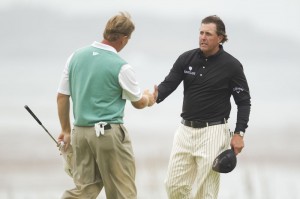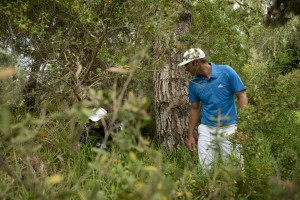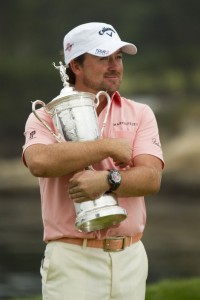Watching the final round of the U.S. Open at Pebble Beach, I was a bit confused. Here I thought I was watching the new U.S. Open, and an old U.S. Open broke out.
Evidence of the new:
The rough lining the fairways was not exceptionally long or thick; a player driving the ball in the rough could reasonably expect to have a shot to the green;
The greens were watered overnight to make sure they did not get out of control;
Some of the fairways were wide;
Tees were moved up on the fourth and 18th holes in a couple of rounds—including the final round—to bring the green in range in less than regulation, creating opportunities for eagles or relatively easy birdies;
Players were using the word “fun.”
So, what happened? It turned into an old-fashioned survival test, the kind of Open that lived up to the old saying: “U.S. Opens are more often lost than won.” The kind of Open that had the best players in the world tripping all over themselves on the way to the clubhouse. The kind of Open where the most memorable Sunday shots were bad ones.*
The kind of Open where the winner was the last man standing.
The kind of Open where the best back-nine score among the players who entered that nine within four of the lead was a 2-over 38 by Gregory Havret. (Winner Graeme McDowell, Phil Mickelson, and Davis Love III had 39s, while Ernie Els and Dustin Johnson had 40s.) Tiger Woods had a 37, not exactly great shakes, and he was five strokes back at the turn after a 3-over 38 on the front nine.
*For my money, the most memorable shots were the two consecutive foozles by Dustin Johnson on the second hole, leading to a triple bogey that wiped out his three-stroke lead: A left-handed attempt from tall grass next to a bunker that moved the ball only a few feet, followed by an attempt at a high pitch shot where the club slid under the ball and moved it only a couple of feet.
The circumstances were remarkably similar to T.C. Chen striking the ball twice on a pitch shot at the fifth hole at Oakland Hills in 1985 in making a quadruple bogey; that one entirely wiped out a four-stroke lead. While Chen’s gaffe was a double-hit, I’m calling Johnson’s a double dribble.
As far as the memorability of McDowell’s play, it’s telling that in Golf.com’s PGA Tour Confidential discussion, the only writer/editor who mentioned anything being memorable got it wrong. Damon Hack pointed to McDowell’s “marvelous comeback on Saturday’s back nine. He fought back to shoot 71 after a bad start, and that gave him some good mojo going into Sunday’s final round.” Uh, no. McDowell got off to a good start on Saturday, then shot a 38 on the back nine with bogeys on 16 and 17.
It looks like the U.S. Open will always be the U.S. Open. Course set-up man Mike Davis in his five years on the job has deservedly won raves for his sensible innovations like graduated rough and variable tee markers, for his willingness to widen fairways and shorten rough when appropriate, and for his caution in making sure that conditions don’t spin out of control as they did at Shinnecock Hills in 2005. Still, his bosses at the USGA wouldn’t have put him in charge if he disagreed with the idea that the U.S. Open should have the “imprimatur” (as USGA executive director David Fay likes to call it) of being the hardest tournament of the year.
One reason the U.S. Open is tough is because it is held on courses that are demanding in the first place. And the USGA course set-up is still tough because the rough is still longer than most tournaments and the greens are firmer than most tournaments.
The innovations on tee placement help lower scoring by giving players more birdie holes. The effect of graduated rough (shorter rough closer to fairways) is less clear. Intuitively, one would think that would aid scoring. Some argue that it doesn’t really, because it’s hard to hit the green from the rough, and then you’re left with some really tough short-game shots to U.S. Open greens. It’s impossible to answer definitively, but my take is that it does help scoring somewhat—after all, players do sometimes hit the green from the lighter rough.
The reason the U.S. Open is as tough as ever is the firmness of the greens. Advances in agronomy and greenkeeping enable putting surfaces to be kept firmer than ever before. The good side of this is that it demands quality shots and imagination by the pros. The bad side, if you like to see birdies, is that it makes it harder to hit approach shots close to the hole.
Davis and company have done a good job of seeing that the greens don’t become so rock-hard as to become a travesty. But Pebble Beach has the smallest greens of any U.S. Open course. When they get really firm, they become effectively even smaller.
In the past, Pebble Beach has become a survival test only in severe weather, as in the final rounds of 1972 and 1992. When conditions were relatively calm, like in the first two rounds of 1992, scores were pretty low.
This year, weather conditions in the final round were fairly benign, yet what we saw was a survival test. The difference was greens that were described in the run-up to the championship as “the firmest ever.”
Added to that is the now-famous (or infamous) bumpiness of Pebble Beach’s poa annua greens. Woods described them as “awful.” A few other pros agreed with him on the record, and many others doubtless felt the same way but didn’t say so. To this, I say if pros want to see awful greens, they should see some of the ones I’ve had to putt on over the years. I will grant, though, that with the speed of U.S. Open greens, any bumps tend to be accentuated.
The difficulty of Pebble’s greens, as I see it, more than the bumpiness, is the sheer speed of the surfaces in a U.S. Open, combined with their slopes. It’s tough to make anything from above the hole—but tough to keep your approach shots below the hole because the greens are so small that sometimes you’ve just got to play for the center of them no matter if that leaves you a downhill putt. The price for firing at the flag and missing the green is even greater.
This Open wasn’t devoid of excitement or low scoring when you look at the big picture of all four rounds. McDowell shot a 68 and Mickelson a 66 on Friday and Woods a 66 on Saturday. There were four 68s on Sunday—but none of them were shot by contenders.
So, again, I say, what happened? Why, when some of the best players in the world were involved, did the stretch run evoke the thoughts of New York Mets manager Casey Stengel: “Can’t anybody here play this game?”
One possible answer is U.S. Open pressure. The national championship means so much to players that the pressure is magnified. An excess of nerves can lead to bad swings and an excess of angst can lead to poor decisions.

Ernie Els and Phil Mickelson shook hands on Sunday, but not on a job well done. Copyright USGA/Mike Ehrmann
This is not a new thought. Original Golf World editor Bob Harlow had an ongoing debate with his friend Richard Tufts of the USGA in the late 1940s and early 1950s. Tufts said that it was the pressure of the U.S. Open that led to high scores; Harlow said it was the course set-ups, particularly the rough around the greens. (Here’s where I plug my book on the 1950 U.S. Open, Miracle at Merion, coming out in October.)
As in many either/or discussions, the answer is actually “both.” It’s probably true that U.S. Open pressure leads to more funny shots and shaky putting strokes, but the course set-up ensures that those shots will be more severely penalized than at another tournament.
At Pebble Beach, though, three of the players who couldn’t get it done were proven multiple major champions—Tiger Woods, Phil Mickelson, and Ernie Els. Were they really shot down by nerves?
In Els’s case, I would say yes. He hasn’t won a U.S. Open since 1997 or a major since 2002 and it appeared that he may have wanted it too badly—confirmed, perhaps, by the fact that he stalked off the course without talking to anybody. More than any of the other contenders, Els can feel like he should have won the U.S. Open. Tied with McDowell at one point of the front nine at 3-under, Els played the last 10 holes in 5-over, including a double bogey at the 10th where he went over the cliffs not once, but twice.
Normally, you wouldn’t expect Woods to be bothered by nerves. But he is still in the midst of a comeback after a well-documented five-month absence. While the enormity of trying to win a U.S. Open might not have bothered him, he may lack full confidence in his game at this point and his unsettled private life might leave him without his usual focus. Those factors could have made him more prone to succumbing to the difficulties of a U.S. Open course.
As for Mickelson, he can go either way. He’s a four-time major champion, but his history down the stretch at a U.S. Open isn’t exactly a good one.
I’m not even sure I buy the thought that McDowell won because he handled the pressure better than anyone. He shot a 74 in the final round, after all. Basically, he won because of his play on Thursday and Friday, which gave him a cushion over everyone else—and then handled the final-round pressure better than Johnson or Els, the two players who were ahead of or tied with him on Saturday and Sunday.
If anyone handled the pressure the best, it was the unheralded Havret. Then again, he did hit a bad putt on the 72nd hole when he had a chance to tie.
It’s possible that it’s mere coincidence that everybody went the wrong way on the back nine on Sunday. Maybe that group of six or seven players just didn’t happen to play well that day. McDowell himself said that he was surprised scores weren’t better—he didn’t think the set-up was that severe.
It can work the other way, too. Shinnecock Hills in 2005 could have been an unmitigated train wreck of a championship, with the winner shooting 76 or worse, but, against the odds, it happened that Retief Goosen and Mickelson played great that day, rescuing the tournament. This time, unfortunately, nobody seemed to be on top of their game.
Of course, saying it was a coincidence is not as much fun as saying, “What a bunch of choke artists!” or “That course was so brutal that no one could play it!”
The bottom line: Is this the best way to determine a championship?
There are some people who take pleasure in watching the pros struggle, which makes them look more like us. And others who, while not taking pleasure, believe that being forced to tackle the ultimate test is the best way to determine the national champion. They wouldn’t want to see it every week, but once a year, with the biggest title on the line, they consider it appropriate. And it must be said that the difficulty gives the U.S. Open an identity.
It’s often not great entertainment, though. Sunday’s final round actually was shaping up as a very interesting one through much of the front nine—not coincidentally when there were birdies being made as well as bogeys, doubles, and triples. Then, for me, it went flat. Or, worse than flat. It was downright frustrating watching the best players in the world not being able to muster the play required to produce the dramatic finish that we craved.
Whether that was more the fault of the players themselves or the course set-up is hard to say. But I do think that setting up the course where birdies and bogeys are both very much in the picture is best for leaderboard volatility and spectator entertainment. A march to victory with a string of pars (or, in McDowell’s case, pars and bogeys) is not exactly stirring.
More important is the question of identifying the best champion. I don’t believe that the harder the course, the more deserving the champion. I think that there’s a tipping point where a course becomes so hard that players aren’t able to fully utilize their skills, and it becomes a bit of a crapshoot (1999 British Open at Carnoustie, anyone?). I also believe that in order to give the best players the best chance, some opportunities for aggressive play must be offered.
Under Davis, I believe the USGA is moving in the right direction. I’d like to see it move a little farther, though, so there’s less of a possibility of a final round where every single contender is in retreat.


